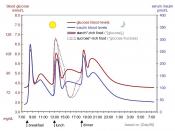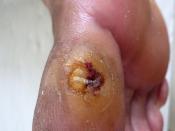Diabetes Mellitus, disease caused by defective carbohydrate metabolism and characterized by abnormally large amounts of sugar in the blood and urine. Diabetes mellitus affects approximately five percent of the United States population, about 10-12 million people, of whom about half remain undiagnosed. Diabetes mellitus can eventually damage the eyes, kidneys, heart, and limbs, and can endanger pregnancy. Proper treatment, however, can minimize these complications.
Diabetes mellitus is usually classified into two types. Type I, or insulin-dependent diabetes mellitus (IDDM), formerly called juvenile-onset diabetes, which occurs in children and young adults, has been implicated as one of the autoimmune diseases. Rapid in onset and progress, it accounts for about 10 to 15 percent of all cases. Type II, or non-insulin-dependent diabetes mellitus (NIDDM), formerly called adult-onset diabetes, is usually found in persons over 40 years old and progresses slowly. Often it is not accompanied by clinical illness and is detected instead by elevated blood or urine glucose levels.
Cause and Course
Diabetes is considered a group of disorders with multiple causes, rather than a single disorder. The human pancreas secretes a hormone called insulin that facilitates the entry of the sugar glucose into all tissues of the body, providing energy for bodily activities. In a person with diabetes, however, the entry of glucose is impaired, a result either of a deficiency in the amount of insulin produced or of altered receptor cells (see Disease). Consequently, sugar builds up in the blood and is excreted in the urine. In the Type I diabetic, the problem is almost always a severe or total reduction in insulin production. In the Type II diabetic, the pancreas often makes a considerable quantity of insulin, but the hormone is unable to promote the entry of glucose into tissues. In some persons this resistance...


